At Baker Home Energy, we’re always working to bring our customers the smartest energy solutions. We’re proud to announce that we were the first company in San Diego to install an SDG&E-approved Non-Export Solar Energy System—a breakthrough that unlocks new options for homeowners under older net metering agreements.
What’s the Big Deal?
Until now, NEM 1.0 and NEM 2.0 customers risked being bumped to less favorable NEM 3.0 rates if they made changes to their system—like adding solar panels or a battery. A Non-Export System gets around that. It allows you to expand your system without exporting excess energy to the grid, so you keep your original NEM status and avoid the financial penalties of NEM 3.0.
What Does This Mean for You?
If you’re on NEM 1.0 or 2.0 and want to add more solar or a battery, you’ve probably been told you’d lose your current rate plan. Not anymore.
Here’s what a Non-Export System lets you do:
- Keep Your NEM 1.0 or 2.0 Status – Add solar or battery storage without triggering NEM 3.0.
- Stay Energy Independent – Generate and store your own power, reducing reliance on SDG&E.
- Optimize Financial Returns – Use stored energy during peak pricing hours to save even more.
- Avoid Changing Utility Rules – Don’t get caught off guard by evolving net metering regulations.
Is This Right for You?
A Non-Export System could be the right move if:
- You’re under NEM 1.0 or 2.0 and want to add solar or battery storage.
- You have high utility bills, especially during evening hours.
- You’re concerned about power outages or future grid instability.
How Does a Non-Export System Work?
A Non-Export System combines solar panels and a battery to power your home—without sending excess energy back to the grid. The system is designed to intelligently manage your energy: solar charges your battery during the day, and your home uses that stored energy when needed.
Why does this matter? Because exporting energy to the grid—especially beyond certain thresholds—can trigger a shift to NEM 3.0, which comes with reduced compensation and longer payback periods. With a Non-Export System, you avoid that completely.
Why Baker Home Energy?
We’ve been helping San Diego homeowners gain energy independence for over 86 years. Now, as the first installer in the region approved by SDG&E for Non-Export Systems, we’re leading the way again.
If you’ve been holding off on expanding your system because of NEM 3.0—you don’t have to anymore. Let’s talk about how we can help you get more out of your energy setup without giving up your favorable rates.



